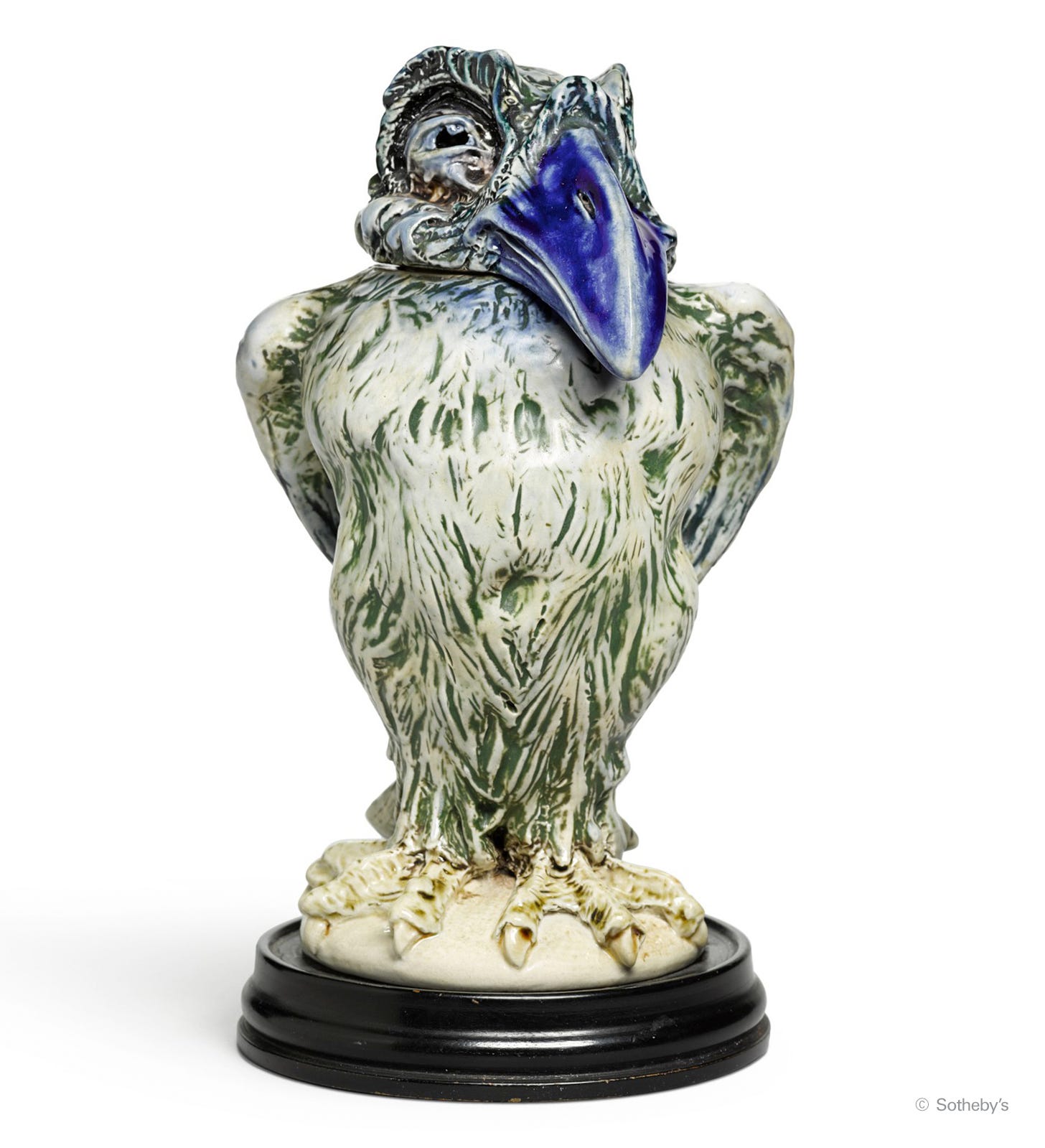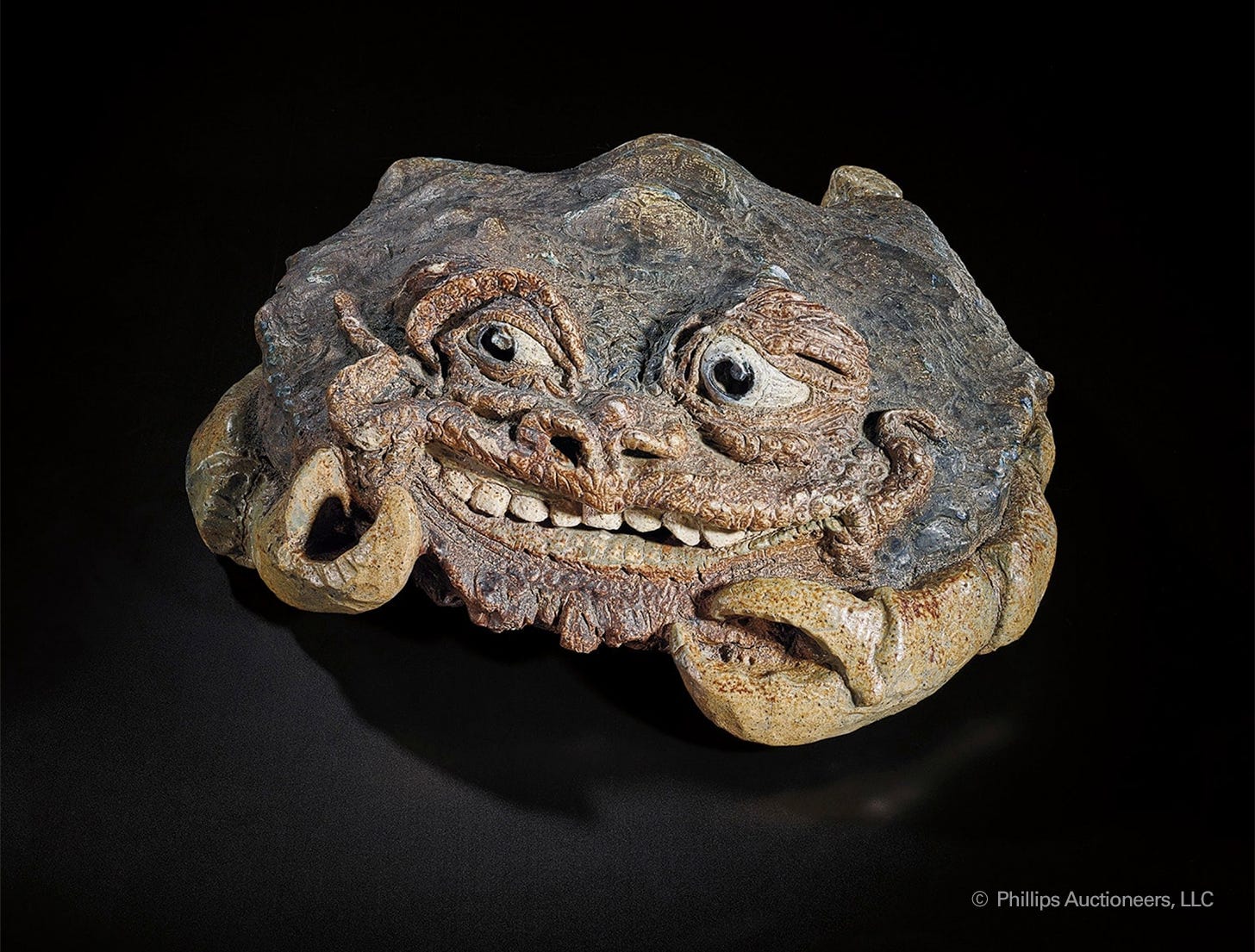Hello, my lovely paid subscribers! Have I mentioned how good-looking you all are? And so smart!
So, I went through the stuff left over from my email earlier this week, and I’ve decided to tell you about Wally Birds. (That’s one of them up above.) Wally Birds were the creation of four brothers — Robert, Walter, Charles and Edwin Martin — who are credited with starting Britain’s first art pottery. Based in London from 1873 to 1914, the Martin brothers created a lot of perfectly nice pots in neutral colors, but they ALSO made some amazingly bonkers other stuff, and that stuff is particularly collectible today.
Like, look at this crab:
Phillips Auctioneers sold this guy — who they dubbed a “colossal and extraordinary grotesque grinning crab” — in 2018 for $275,000. No, seriously. Here’s the link. It came in around mid- to low-estimate.
The crab dates to June 1880, and you have to remember that this was the onset of the Industrial Age, when cheap, mass-market goods were starting to flood the market, and people like John Ruskin and William Morris were warning that the hand of the artist was being lost in the process. So people were looking for real craftsmanship, and the fantastical, one-of-a-kind salt-glazed stoneware creations of the Martin Brothers helped fill the void. They quickly drew fans, with none other than Queen Victoria and members of the Pre-Raphaelite Brotherhood buying their work. Queen Mary even had a bunch of their pieces sent to the Paris Exposition of 1914.
Each brother brought something to the table. Robert Wallace was the eldest, and he was the sculptor. Walter threw the pots and worked with the glazes, Edwin did the decoration and Charles ran the shop.
L-R: Walter F. Martin, Robert Wallace Martin and Edwin Martin (Charles is not pictured).
The tobacco jar birds that Robert started to make in the 1870s — dubbed “Wally Birds” in reference to his name — were immediately popular, and according to the British Antique Dealers' Association, Charles pressed his brother to step up production. It didn’t always work, though:
Creative and commercial tensions often arose between the siblings. Robert Wallace, dedicated primarily to his artistry, continued to push Victorian boundaries with Birds increasingly fanciful and grotesque — which Charles repeatedly cautioned against.
Charles wasn’t much help himself, either — he would literally hide pieces he didn’t want to sell under the floorboards of the shop.
In general, even though the brothers were an extraordinary creative force, they were a disaster when it came to business. They couldn’t afford good clay, and they were also too poor to fire their kiln more than a couple of times a year, a process that this New York Times article from 1981 describes as:
“a complex and crucial process that has been described as ‘excruciating events in which the Martins hobbled around damaging toes as they scrambled to cast their furniture into the kiln in an effort to keep the fire alive for the requisite 48 hours.’”
Catastrophically, their shop burned down in 1903, taking years of work along with it. Charles was blamed, and according to that same New York Times article, he tried to throw himself out a window as a result. He was eventually diagnosed insane and died in an asylum, and over the next few years, two of the other brothers were also lost — Edwin to facial cancer and Walter to a cerebral hemorrhage that was the result of a workplace injury.1 Robert was the last one left standing, and a couple of years before his death in 1923, he witnessed Martin Brothers pottery selling for large sums at a Sotheby’s auction. A friend who was with him at the time noted his reaction as he stated: “‘And we, my brothers and me, never got more than labourers’ wages,’ but it was said without bitterness.”
A Martin Brothers double face jug, 1897. Sold at Rago in 2020 for $8,125.
Anyway, on to the birds.
An article in an 1882 edition of the Magazine of Art describes them, and Robert’s other creatures, as:
“nonsense indeed, but good nonsense, which is even more difficult to carve than to write. It takes a wise man to be a fool of this calibre, and he would deserve to be prized if only for his rarity. We have a hundred young sculptors who will model you a Venus or an Adonis as soon as look at you; but who save Mr. Martin who could give you a Boojum or a Snark in the round?”
Robert’s birds weren’t modelled after any particular species, unless we’re talking about humans. His birds were anthropomorphic; some were caricatures of well-known public figures, while others were plays on broader groups like barristers or monks. They're all individual and immensely charismatic, with sidelong glances and mischievous looks that easily seduce collectors, and David Rago of Rago Auctions in Lambertville, Pa. explains the appeal as:
“They’re really expressive creatures, and a lot of fun. It’s like they are having a conversation with each other. Expression is so much of what these things are about. They’re pretty snarky. I don’t know of any that are benign.”
Rago had a very successful Martin Brothers sale back in 2019, but the world sale record is held by this bird, an 1889 caricature of Prime Minister Benjamin Disraeli that was sold at Phillips in 2015 for $233,000:
The bird that heads up this post (and who prompted this whole email) is included in the Sotheby’s online Furniture, Silver, Clocks & Ceramics auction that closes next Tuesday. Dated 1902, it has a few restored chips, but still carries an estimate of £7,000 – £10,000, or $8,586 – $12,265. As of Friday night — wait, no, it’s Saturday morning now, lol — it already had a current bid of £7,500 ($9,199). I’m curious to see how it’ll do.
I’ll close this out with a few more birds, just because. The bird below dates to February 1898 and it’s a caricature of the barrister and politician Sir Edward George Clarke QC, who was famous for (unsuccessfully) representing Oscar Wilde in his libel trial, and also cross-examining the then Prince of Wales in the Royal baccarat case. It was included in the Phillips New York Design Evening auction in 2018 and sold for $175,000.
This one, a monk bird from 1895 that sold at Woolley & Wallis in their 2015 British Art Pottery auction for £30,000 ($36,795), is basically Sam the Eagle with a tonsure:
And the one below, a tall “Jubjub” bird with an open beak, dates to October 1890 and sold for $68,750 in the Phillips Martinware auction in New York in 2015. With only 23 lots, there’s a delightful (and not overwhelming) range of birds in that auction, as well as a few of Robert’s “grotesques” — basically unidentifiable but charming little creatures — so I recommend clicking through to have a quick browse. (I particularly love this one, because it’s literally my baseline mood depicted in stoneware.)
Ok, that’s it. As always, I’ve gone on too long, but believe me when I say I have practiced great restraint with this one, because I LOVE these things. So, I hope you’ve enjoyed this little journey through one of the more whimsical (but sad) corners of British Arts & Crafts history, and thank you again for your support!
Enjoy your weekend,
M xx
Also, according to that New York Times article, their sister died of a monkey bite!? I have not been able to find anything further on that — YET — but I will keep looking because I clearly have nothing better to do with my life.












I love that cursed crab with my whole heart!!!
Also, there are A LOT of Jabberwocky references here, both in the contemporary review and the names of some of the auctioned pieces, which thrilled my Lewis Carroll-loving heart. Any sense of how that association came to be? The Martins didn't call them by those names did they?
This was thoroughly delightful!
These things are tremendous! I need to bring that pitcher, full of rum punch, to my next am Directors meeting.